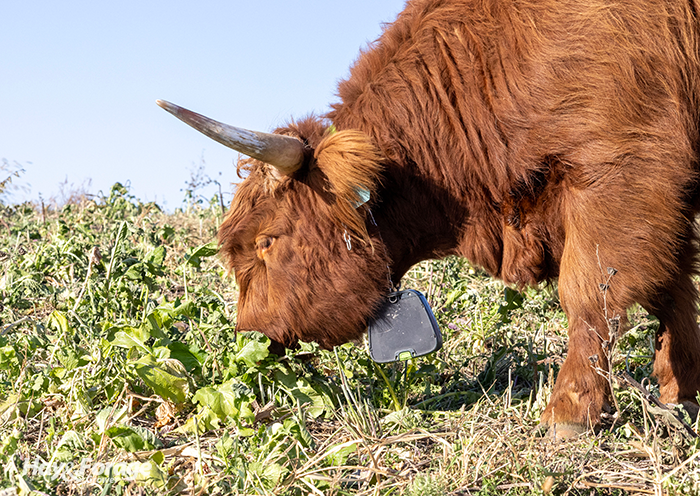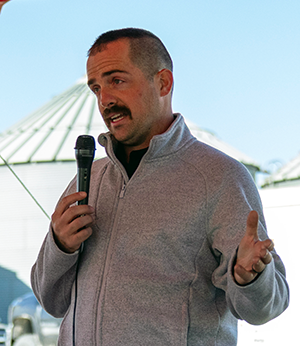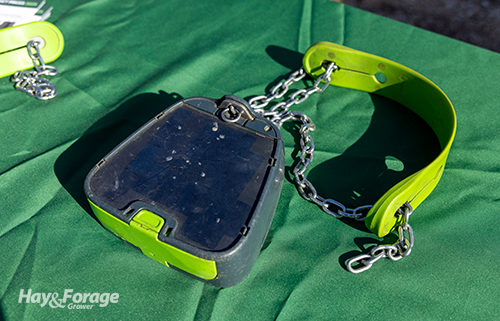
Virtual fencing is not a new concept, but its adoption by livestock producers is constantly growing and changing. There are essentially as many strategies for virtual fencing as there are farmers using the technology, and with four companies offering different virtual fencing options on the market, it can be difficult to know where to start.
Getting started with and making the best use of virtual fencing was the focus of a precision livestock technology field day held earlier this month at Resilient Farms in Red Oak, Iowa. The field day was coordinated by Iowa State University (ISU) and South Dakota State University (SDSU) extension specialists.
Matt and Jocelyn Vermeersch started renting Resilient Farms two years ago and have established a succession plan with the current landlords to gradually acquire land ownership. They are also in the midst of transforming the corn and soybean acres into permanent pasture for their Scottish Highlander cattle and goat herds.

Before establishing permanent pastures, the Vermeersches have been renovating the row-crop operation by seeding annual forages and grazing cover crop mixes. They have also gotten creative in their grazing management, considering the riparian areas, terraces, and lack of viable fencing in the fields. Virtual fencing was a solution to make the most of their limited forage and pasture infrastructure.
In addition to keeping livestock contained and being a rotational grazing tool, virtual fencing can have positive effects on farmers’ pocketbooks, animal health, and overall herd performance. There are some drawbacks, though. Erika Lundy-Woolfolk, an extension beef specialist with ISU, and Jamie Brennan, an extension livestock grazing specialist with SDSU, explained some of those strengths and weaknesses during the field day.
Reduced fencing costs. Like the Vermeersches, many farmers utilize virtual fencing in fields that aren’t necessarily set up for grazing. After installing 7,000 feet of permanent fence last spring, the Vermeersches said investing in virtual fencing technology was more cost-effective than continuing to divide large pastures into smaller sections with five strands of high tensile wire.
Brennan added that virtual fencing can be a less expensive solution to exclude animals from sensitive areas like riparian buffers and waterways. In his region of western South Dakota, farmers also use virtual fencing to graze hunting ground without needing to install barbed wire that could otherwise interfere with hunting activity.
Using virtual fence to graze cornstalks is another way to take advantage of an underutilized forage source on crop fields without proper fences. “I’ve done the math, and we could graze the whole U.S. cow herd on our Iowa cornstalk acreage for 60 days and still only use about half of it,” Lundy-Woolfolk said. “With virtual fence collars on, we can move cattle and strip graze cornstalks for better utilization.”
Even so, Lundy-Woolfolk advised the audience that virtual fencing should not be a substitute for a perimeter fence that meets legal standards.
Time and labor savings. Each of the four virtual fencing options — Vence, Nofence, Halter, and eShepherd — include GPS-enabled collars, and all systems are controlled in-app. Farmers simply use their smartphones or tablets to draw virtual boundaries, edit invisible fence lines, and move cattle from one paddock to the next.
“The great thing about virtual fencing is that it offers the ability to move cows from anywhere,” said Lundy-Woolfolk, who also manages a beef operation in southwest Iowa with her husband, although both of them work full time off the farm. “The flexibility to be able to move cows while you are sitting at a desk job or at a kid’s ballgame is a nice opportunity.”
Labor for fence repairs is also saved. And if cattle do go beyond virtual boundaries, farmers are notified instantly, reducing the time it takes to corral animals back into the correct pasture.
Better herd management. In addition to tracking animal location and sending alerts about escapees, virtual fence collars can track different grazing behaviors and herd health metrics, depending on the company. For instance, the Vermeersches utilize grazing distribution heat maps on their Nofence app to plan pasture moves. Other options include notification preferences for less movement or greater lying time by individual cows, which could indicate illness. Some features can even aid in breeding and calving.
“Some of the collars monitor estrous expression to know if those females are cycling, and that can help us pinpoint what our breeding season will look like,” Lundy-Woolfolk said.

Virtual fences can also be useful in managing multiple groups of animals at one time. In a cow-calf operation, this might look like creating a virtual fence line for cows wearing collars while calves creep graze beyond those invisible boundaries — like a leader-follower approach. “We want that younger animal with a higher nutritional requirement to graze ahead of the more mature cows,” Lundy-Woolfolk explained.
It's not a silver bullet
So, what are the downsides? For one, virtual fencing won’t fix poor management. Farmers still need to facilitate grazing rotations and give forage sufficient rest periods. Brennan suggested good grazing management may be even more important with virtual fences since cattle will ignore electric pulses from collars in order to satisfy their basic needs for feed, water, or safety.
“Virtual boundaries are really only as effective as the negative reinforcement compared to the desire on the other side of the invisible line,” Brennan said. “If you run out of forage, cattle might break the boundary. If you accidentally fence out your water, they might run across that line.”
Some audience members raised concerns about collar maintenance and connectivity, for which the four virtual fence companies have different solutions. Nofence, Halter, and eShepherd collars are solar powered, whereas Vence collars run on a battery. Moreover, Halter and Vence use long-range communication (LoRa) to connect to base stations, while eShepherd utilizes cellular networks, and Nofence has the option for both. Each company also has different subscription models and price offerings, so farmers must do their research to find the best fit for their operation.
Overall, virtual fencing may not be a good fit for every animal. Although the four companies all report high success rates, there will always be a few stubborn cows that don’t comply with the technology.
“Virtual fence isn’t perfect, but neither is our traditional fence,” Lundy-Woolfolk said. “We don’t have 100% containment from traditional fence, either, so it is still a good comparison from that perspective.”

